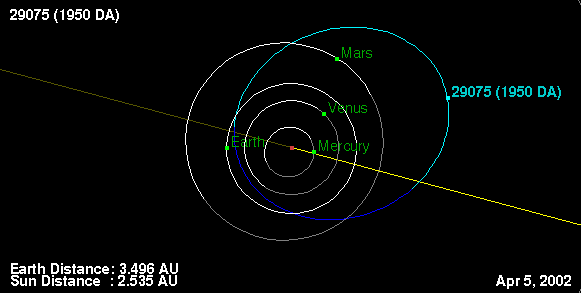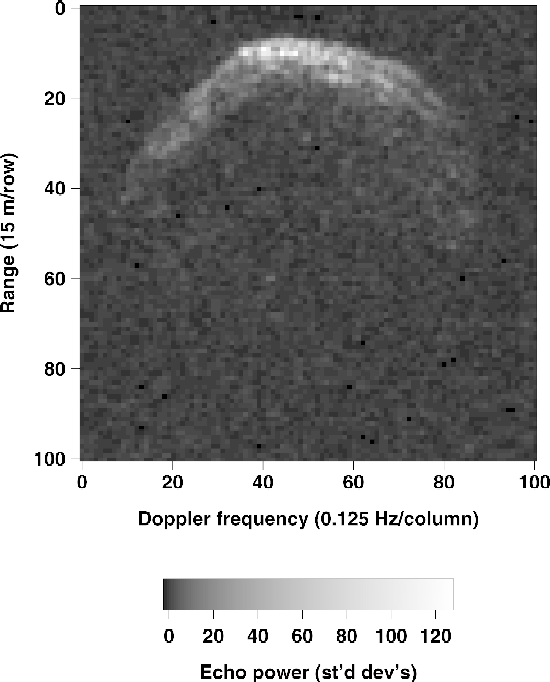
Image 1 Caption: The orbit of NEA (near Earth asteroid) and PHA (potentially hazardous asteroid) 1950 DA (AKA asteroid 29075) discovered 1950 Feb23 by Carl A. Wirtanen (1910--1990).
The calendar date of Image 1 is 2002 Apr05. Shown in Image 1 are the Sun ☉, Mercury ☿, Venus ♀, Earth ⊕, Mars ♂, and 1950 DA.
Features:
- 1950 DA facts:
- Mean orbital radius (AKA semi-major axis): 1.69884271 AU.
- Eccentricity: 0.507424557 ≅ 51 %.
- Orbital inclination to the ecliptic plane: 12.1843194°.
- Orbital period: 808.59 days = 2.2138 Julian years.
- Rotational period: 2.1216 hr.
- Dimensions: 1.39 x 1.46 x 1.07 km. It is NOT very round as dimensions show. Self-gravity is far too weak to spherize 1950 DA. It does have a large equatorial bulge due the centrifugal force caused by its fast rotation.
- Mean diameter: 1.3 km.
- Below in Image 2 is a radar image
of 1950 DA:

Image 2 Caption: A radar image of 1950 DA (asteroid 29075) from the Arecibo observatory, 2001 Mar04.
Yours truly is NOT actually quite sure what we are seeing.
Presumably the horizontal and vertical scales are related to distance on the sky.
Both the download site caption and the Wikipedia caption fail to elucidate very much about Image 2.
- 1950 DA
is considered to be the most
threatening NEO (near Earth object)
(i.e., potential
Earth-impactor).
See NASA/JPL Center for Near Earth Object Studies' (CNEOS')
Sentry Risk Table
where the threat of
NEOs
is ranked by the
Palermo (technical impact
hazard) scale which
combines probability of impact and danger of impact with some weighting.
See also CEOS: 1950 DA for more details on the threat from 1950 DA.
- 1950 DA's
probability of
impact is
3.8x10**(-4) and the
calendar date
of the possible impact
is 2880
Mar16---just before
St. Patrick's Day.
These results are the best estimates
as of circa 2024.
Why CAN'T we be certain about the threat of 1950 DA. It is a smallish asteroid, and therefore subject to many weak astronomical perturbations. These make its orbit decreasingly knowable with high accuracy/precision as time increases from the present and recall the possible impact is over 8 centuries in the future. For impactor threats in general, see Asteroid file: impactor_threat_diagram.html.
- 1950 DA was first discovered
1950 Feb23
as aforesaid---and then lost---but was recovered on
2000 Dec31
(the last evening of the 20th century by the logical, but
not popular, definition).
- 1950 DA
is a temporary name indicating the year of discovery.
It is also known asteroid 29075.
Probably, there is NO suitable permanent name for the most threatening asteroid.
- 1950 DA
is ∼ 1.3 km in size scale. So according to the threat diagram
in Asteroid file:
impactor_threat_diagram.html,
it could cause continental devastation.
- Should we do anything about
1950 DA?
Well, we have a long time to think about it.
But what can we do if it's going to hit? A small artificial astronomical perturbation early on would deflect it. Just a small push perhaps or just changing its reflectivity by covering it with soot.
In fact, 1950 DA's probability of hitting us will likely change long before 2880 as its orbit becomes better known: growing maybe, but most likely diminishing to nothing.
So for now, we should just keep monitoring 1950 DA and let the folks in 29th century worry about it. One wonders who they might be.
Come what may, in 2880, there will still be a St. Patrick's Day (Mar17).
- 1950 DA videos (i.e., 1950 DA videos): Doomsday is always popular:
- 1950da Asteroid Impact Simulation | 0:20: A tsunami simulation from an impact of 1950 DA at about the Bermuda vertex of the Bermuda Triangle. Short enough for the classroom.
- Asteroid 1950 DA - Video File (AVC-2002-054 | 9:30: It's from Jet Propulsion Laboratory (JPL), and so authoritative. Good, but not very slick. Too long for the classroom. Show from 0:38 on for a few seconds.
- 1950 DA videos (i.e., 1950 DA videos): Doomsday is always popular:
-
Images:
- Credit/Permission
NASA,
JPL,
J. Giorgini,
before or circa 2012 /
Public domain.
Download site: NASA, JPL: 29075 (1950 DA).
Image link: Itself.
- Credit/Permission
NASA,
JPL,
S. Ostro,
2001 /
Public domain.
Download site: NASA, JPL: 29075 (1950 DA): See also the Wikipedia caption.
Image link: Itself.
File: Asteroid file: 1950_da_orbit.html.